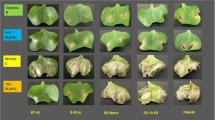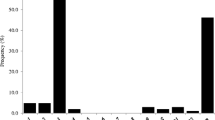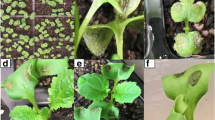Abstract
Germplasm from Australia, China and India was screened for resistance to blackleg (phoma stem canker), caused by Leptosphaeria maculans, under Australian field conditions. More than half of the world’s races of L. maculans occur in Australia, and sites were chosen to encompass areas of high race diversity. Plots were sown into the previous season’s L. maculans-infested residues. Significant differences in response were observed among genotypes of both Brassica napus and B. juncea when tested in Victoria, South Australia and Western Australia. Significant differences in response were observed among B. juncea, but not B. napus genotypes, when tested in New South Wales. Differences in the relative degree of expression of host resistance were observed between some test sites in relation to Australian cultivars that either contained major gene-based resistance (e.g. Surpass 400) or those that effectively had only polygenic resistance (e.g. AV-Sapphire, Lantern, Monty, Rainbow and Trigold). Australian genotypes, especially of B. napus, are generally more resistant than the Chinese and Indian genotypes. The majority of the B. juncea genotypes from both China (e.g. Xinyou 5) and India (e.g. Rohini) showed a high level of resistance, while some B. napus genotypes (e.g. 04-P34, P617 and P624 from China) showed at least a low level of resistance. Promising Australian B. napus germplasm in particular may provide high levels of polygenic resistance to both India and China should the disease become established in one or both those countries.
Similar content being viewed by others
References
Anon. (2004) Blackleg resistance breakdown in canola varieties containing ‘sylvestris’ resistance. National Recommendations for 2004. Canola Association of Australia and Oilseeds Western Australia, Miscellaneous Bulletin. 2 pp.
Balesdent MH, Barbetti MJ, Hua Li, Sivasithamparam K, Gout L, Rouxel T (2005) Analysis of Leptosphaeria maculans race structure in a worldwide collection of isolates. Phytopathology 95, 1061–1071. doi: 10.1094/ PHYTO-95-1061
Ballinger DJ, Salisbury PA (1996) Seedling and adult plant evaluation of race variability in Leptosphaeria maculans on Brassica species in Australia. Australian Journal of Experimental Agriculture 36, 485–488. doi: 10.1071/EA9960485
Barbetti MJ (1975) Effects of temperature on development and progression in rape of crown canker caused by Leptosphaeria maculans. Australian Journal of Experimental Agriculture and Animal Husbandry 15, 705–708. doi: 10.1071/EA9750705
Fitt BDL, Brun H, Barbetti MJ, Rimmer SR (2006) World-wide importance of phomastem canker (Leptosphaeria maculans and L. biglobosa) on oilseed rape (Brassica napus). European Journal of Plant Pathology 114, 3–15. doi: 10.1007/s10658-005-2233-5
Fitt BDL, Hu BC, Li Z, Liu S, Lange RM, Kharbanda PD, White RP (2007) Strategies to prevent spread of Leptosphaeria maculans (phoma stem canker) onto oilseed rape crops in China. In ‘Proceedings of the 12th International Rapeseed Congress, Wuhan, China. Vol. IV’. (Eds T Fu, C Guan) pp. 28–31. (Science Press USA Inc.: Monmouth Junction, NJ)
Gororo N, Salisbury P, Marcroft S (2004) Dunkeld and Rainbow: a tale of two Victorian canola cultivars. In ‘Proceedings of the 4th International Crop Science Congress, Brisbane, Queensland, Australia’. Available at http://www.regional.org.au/au/cs/2004/poster/3/7/3/975_gororo.htm [Verified 14 January 2008]
Gugel RK, Petrie GA (1992) History, occurrence, impact and control of blackleg of rapeseed. Canadian Journal of Plant Pathology 14, 36–45.
Hua Li, Barbetti MJ, Sivasithamparam K (2003) Responses of Brassica napus cultivars to Leptosphaeria maculans field isolates from Western Australia. Brassica 5, 25–34.
Hua Li, Damour L, Barbetti MJ, Sivasithamparam K (2004) Increased virulence and physiological specialization among Western Australian isolates of Leptosphaeria maculans breaking down existing single dominant gene-based resistance in six cultivars of Brassica napus. Brassica 6, 9–16.
Hua Li, Barbetti MJ, Sivasithamparam K (2005) Hazard from reliance on cruciferous hosts as sources of major gene-based resistance for managing blackleg (Leptosphaeria maculans) disease. Field Crops Research 91, 185–198. doi: 10.1016/j.fcr.2004.06.006
Hua Li, Smyth F, Barbetti MJ, Sivasithamparam K (2006) Relationship in Brassica napus seedling and adult plant responses to Leptosphaeria maculans is determined by plant growth stage at inoculation and temperature regime. Field Crops Research 96, 428–437. doi: 10.1016/j.fcr.2005.08.006
Li H, Sivasithamparam K, Barbetti MJ (2003) Breakdown of a Brassica rapa subsp. sylvestris single dominant blackleg resistance gene in B. napus rapeseed by field isolates in Australia. Plant Disease 87, 752. doi: 10.1094/PDIS.2003.87.6.752A
Rouxel T, Willner E, Coudard L, Balesdent MH (2003) Screening and identification of resistance to Leptosphaeria maculans (stem canker) in Brassica napus accessions. Euphytica 133, 219–231. doi: 10.1023/A:1025597622490
Salisbury PA, Ballinger DJ, Wratten N, Plummer KM, Howlett BJ (1995) Blackleg disease on oilseed Brassica in Australia: a review. Australian Journal of Experimental Agriculture 35, 665–672. doi: 10.1071/EA9950665
Sivasithamparam K, Barbetti MJ, Hua Li (2005) Recurring challenges from a necrotrophic fungal plant pathogen: a case study with Leptosphaeria maculans (causal agent of blackleg disease in Brassicas) in Western Australia. Annals of Botany 96, 363–377. doi: 10.1093/aob/mci194
Sosnowski MR, Scott ES, Ramsey MD (2001) Pathogenic variation of South Australian isolates of Leptosphaeria maculans and interactions with cultivars of canola (Brassica napus). Australasian Plant Pathology 30, 45–51. doi: 10.1071/AP00064
Sosnowski MR, Scott ES, Ramsey MD (2004) Infection of Australian canola cultivars (Brassica napus) by Leptosphaeria maculans is influenced by cultivar and environmental conditions. Australasian Plant Pathology 33, 401–411. doi: 10.1071/AP04045
Thomas V, Salisbury P, Norton R, Marcroft S (2007) The current situation in the Brassica juncea—Leptosphaeria maculans pathosystem and how future changes will be monitored. In ‘Proceedings of the 12th International Rapeseed Congress, Wuhan, China. Vol. IV’. (Eds T Fu, C Guan) pp. 213–216. (Science Press USA Inc.: Monmouth Junction, NJ)
West JS, Evans N, Liu S, Hu B, Peng L (2000) Leptosphaeria maculans causing stem canker of oilseed rape in China. Plant Pathology 49, 800. doi: 10.1046/j.1365-3059.2000.00503.x
West JS, Kharbanda PD, Barbetti MJ, Fitt BDL (2001) Epidemiology and management of Leptosphaeria maculans (phoma stem canker) on oilseed rape in Australia, Canada and Europe. Plant Pathology 50, 10–27. doi: 10.1046/j.1365-3059.2001.00546.x
Author information
Authors and Affiliations
Corresponding author
Rights and permissions
About this article
Cite this article
Li, C.X., Wratten, N., Salisbury, P.A. et al. Response of Brassica napus and B. juncea germplasm from Australia, China and India to Australian populations of Leptosphaeria maculans . Australasian Plant Pathology 37, 162–170 (2008). https://doi.org/10.1071/AP08005
Received:
Accepted:
Issue Date:
DOI: https://doi.org/10.1071/AP08005




